Vol 2 No. 37 TROPIC LIGHTNING NEWS September 18, 1967
Index
Four Win DSCs for 25th's Biggest Battle
Human Wave Assaults Leave 647 Cong Dead
At daybreak last March 21, three battalions of Viet Cong attacked a
U.S. Army 25th Div forward base camp with human wave assaults which threatened
to overrun its defenders. After a four-hour battle, the enemy retreated
leaving 647 dead behind. American casualties - 31 killed and 109 wounded.
On Aug. 30, four soldiers were cited for "extraordinary heroism
and devotion to duty" during this battle when they received the Nation's
second highest award for heroism - the Distinguished Service Cross.
Three of the men are members of the 2d Bn, 77th Arty: LTC
John W. Vessey, battalion commander from Arlington, Va.; SGT Earl Haupt of
Cincinnati; and SP4 Samuel W. Townsends of Detroit; and SP5 Richard Hazel of
Otter Lake, Mich., who is assigned to the 3d Bn, 22th Inf.
The awards were presented to the men at the 3d Bde's base camp in
Dau Tieng where GEN William C. Westmoreland was present for the ceremony.
"Few men wear this decoration," GEN Westmoreland said, "and
to award four of them at a single formation is, I believe, unique in the history
of this war."
| GEN William C. Westmoreland is flanked by (from left) LTC John W. Vessey, SP5 Richard Hazel, SGT Earl Haupt and SP4 Samuel Townsends. The four soldiers, members of the 2d Bn, 77th Arty, and 3d Bn, 22d Inf, received Distinguished Service Crosses for "extraordinary heroism and devotion to duty" during a Viet Cong attempt to overrun a 25th fire support base. (Photo by SP4 Robert Fungaroli) | 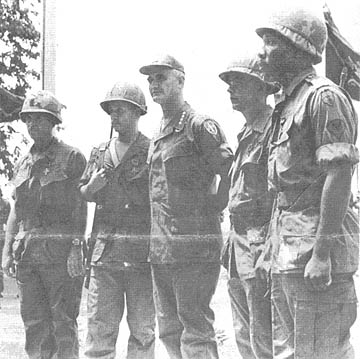 |
Return Fire Ruins M-16
"I could hardly believe my eyes," remarked SP4 Roger D. Burke
of Hingham, Mass., as he looked at his ruined M-16.
During a heliborne assault into the southern portion of the Iron
Triangle, Co D, 4th Bn., 9th Inf, came under sniper fire as they started a sweep
through the area.
"As I scanned the area," Burke continued, "I saw a Viet Cong
off to my left wearing a steel helmet and flak jacket and heavily armed with
hand grenades. I alerted the squad and everybody opened up on him.
The VC dropped as he started to duck behind a rice paddy dike but
at the same time something slammed into me and knocked me into the knee deep
water of the rice paddy.
"I got up and tried to fire my rifle but it wouldn't work.
I started to check it and found that a bullet had knocked out the bolt."
Wolfhound Comrades Contribute
Two infantrymen walked silently to the front of the assembled
battalion and thrust M-16 rifles with bayonets into the hard Vietnamese dirt.
Then, led by their commander, LTC David Hughes of Colorado Springs,
Colo., the men of the 1st Bn, 27th Inf "Wolfhounds," filed silently forward
dropping contributions into a basket in memory of two fallen friends.
The money, donated in the names of CPT Leonard "Jerry" Marcum
and PFC John Yeast, both killed in action during the 25th Div's Operation "Kolekole,"
was mailed to the world famous Wolfhound Orphanage in Osaka, Japan.
More than 850 members of the 25th Inf Div unit had gathered at the
battalion's Cu Chi base for the service. The number included Div
Commander MG F.K. Mearns and Bde Commander COL Edwin W. Emerson.
"It was a sad, yet an inspiring service," said Bn Chaplain (MAJ)
S.L. Shannon. "The Wolfhounds seem to have caught the spirit of
generosity of an earlier war and an earlier generation."
Soon after the end of World War II, the 27th Inf began supporting a
small, half destroyed orphanage in Osaka. Today after nearly 18 years of
continuous support, it stands as one of the finest homes in the Far East.
'Glad To See Sun Come Up'
By SP4 Carlos Webb
"I was never so glad to see the sun come up in my whole
life," said PFC Willie Townsend of Memphis, Tenn., from his hospital bed after
describing the nightlong ordeal of being wounded and surrounded by a Viet Cong
squad in the jungle of the Iron Triangle.
Townsend's story began when his platoon was dropped by
helicopters late in the afternoon with the mission of securing a landing zone
for other elements of the 4th Bn, 9th Inf. Soon after landing they came
under heavy sniper fire.
Townsend and PFC Charles Williams of Cowan, Tex., were moving
toward a tree line for cover when they realized that they were cut off from the
rest of the platoon.
"It was getting dark," Townsend continued, "and all I could
think of was how to get through the VC." As the two started toward the
tree line 100 meters away, a VC stood up and Townsend killed him with a round
from his M-79.
"A second after he dropped, a swarm of his buddies popped out of
the tree line running towards us firing."
Townsend and Williams dropped behind a bank of dirt and returned
fire. "Just as I dropped I felt a burning pain in my elbow," Townsend
said, "and knew that I'd been hit. I remember firing a couple of
magazines but then I must have passed out. The next thing I knew it was
dark and Williams was crouching over me washing my face."
Williams had put a tourniquet on Townsend's arm to stop the
bleeding. "At first I was scared stiff," Williams admitted, "but
then when I saw the condition Willie was in I was more worried about keeping him
alive until we could make it back to the platoon."
"I could hear the VC talking and rustling through the grass all
around us," Townsend went on, "so with Williams' help I was able to crawl
about 40 meters from the VC position where we found a clump of matted grass to crawl under and hide.
"During the night flares lit up the area and I figured our
company was looking for us but we didn't dare move for fear of being spotted
by the VC."
At daybreak gunships made rocket and machine gun runs and the VC
withdrew. Williams threw a smoke grenade to show their location but the
underbrush was too thick for the helicopters to spot them.
"Then Williams and I saw a helicopter land at a position that we
figured was about 1000 meters away," continued Townsend, "and we started
walking toward it. I was pretty weak and, Williams was carrying most of my
weight."
The two soldiers walked and stumbled through the jungle and as they
reached the company's perimeter Townsend collapsed. A dust-off was
called in and Townsend was evacuated to the 25th Div's 12th Evac Hosp.
Williams continued on the mission with his unit.
Camp Hit 6th Time
Cu Chi base camp was hit by enemy mortar fire for the sixth time
when at least 12 82mm mortar rounds fell within its perimeter on Sept. 4.
The attack began at 7:25 p.m. and lasted 21 minutes.
Seven U.S. soldiers were wounded, but overall damage was termed
light by a military spokesman.
Within 10 minutes after the first round fell, counter-mortar
helicopters were in the air. Within five minutes 25th artillery units were
returning fire on the suspected enemy position. Dusters and .50 cal.
machine guns also fired at the position, believed to have been located 3000
meters north of the camp.
Cu Chi base camp was last mortared on July 13 when 15 U.S. soldiers
were wounded. The camp was first hit in June of last year.
Page 2 TROPIC LIGHTNING NEWS September 18, 1967
Decorated
The courageous man is the man who forces himself, in spite
of his fear,
to carry on. Discipline, pride, self-confidence, and the love
of glory
are attributes which will make a man courageous even when he is afraid.
General George S. Patton Jr.
| SILVER STAR | |
|
CPT Thomas A. Brewer, Co A, 2d Bn, 27th Inf CPT Roger L. Taylor, HHC, 1st Bn, 27th Inf SGT Charles E. Roland, A Trp, 3d Sqdn, 4th Cav |
SP4 Lavin Aurelio, Co C, 1st Bn, 27th Inf PFC Jackie D. Holloman, Co A, 1st Bn, 27th Inf |
|
DISTINGUISHED FLYING CROSS |
|
|
COL David E. Ott, HHC, 25th Inf Div Arty |
SP4 Robert L. Taylor, Co A, 25th Avn Bn |
BRONZE STAR (VALOR) |
|
|
MAJ Luther C. Vaughn, HHC, 1st Bn, 27th Inf CPT Frederick C. Phillips, Co C, 2d Bn, 14th Inf 1LT Dennis L. Trippel, Co C, 2d Bn, 14th Inf 1LT William J. Canfield, 116th Aslt Hel Co 2LT Vincent B. McLorg, Co A, 1st Bn, 27th Inf PSG Edward J. Gannon, B Trp, 3d Sqdn, 4th Cav SFC Joseph F. Newton, HHC SP5 Gerald G. Brooks, HHC, 1st Bn (Mech), 5th Inf SGT Lee D. Williams, Co C, 4th Bn (Mech), 23d Inf SGT Henry L. Frazier, Co C, 4th Bn (Mech) 23d Inf |
SGT John Lenrick, Co B, 1st Bn (Mech), 5th Inf SP4 Jerry W. Sellers, Co B, 4th Bn (Mech), 23d Inf SP4 James P. Allgood, A Btry, 1st Bn, 8th Arty SP4 Robert L. Pederson, HO & Svc Btry, 2d Bn, 77th Arty SP4 James L. Danovsky, Co B, 1st Bn (Mech) 5th Inf SP4 Lowell R. Carrico, Co C, 4th Bn (Mech), 23d Inf SP4 Juan P. Rios, Co C, 2d Bn, 14th Inf SP4 George E. Shomo, Co A, 2d Bn, 27th Inf SP4 Charles M. Dunn, Co A, 1st Bn, 27th Inf PFC John E. Johnson, HHC, 1st Bn, 27th Inf |
BRONZE STAR (MERIT) |
|
|
MAJ George F. Newton, Co A, 25th Avn Bn MAJ Richard C. Winder Jr., HHC, 2d Bn, 12th Inf CPT David A. Bujalski, HHC, 65th Engr Bn WOl Harley M. Vincent, Co B, 25th Avn Bn MSG David R. Strandgard, HHC, 2d Bn, 12th Inf PSG Lawrence J. Thomas, HHC, 2d Bn, 12th Inf PSG George F. Lamothe, HHC, 2d Bn, 12th Inf SFC Nelson T. Omero, HQ & Svc Btry, 2d Bn, 77th Arty SSG Robert G. Stapel, HHC, 2d Bde SSG Joseph T. Hocking, Co B,_ 25th Med Bn SSG Robert V. Carmody, HHC, 3d Bn, 22d Inf SSG Charlie Mosley, 2d Bn, 12th Inf SSG Kenneth H. Kruse, Co A, 2d Bn, 12th Inf SGT Richard W. Goodman, HHC, 65th Engr Bn SGT Bobby D. Weldon, A Trp, 3d Sqdn, 4th Cav SGT Loren R. Aase, Co A, 1st Bn (Mech), 5th Inf SGT Raymond L. Leavitt, Co B, 1st Bn, 27th Inf SGT Thomas R. Matteson, Co A, 2d Bn, 12th Inf |
SGT Herbert E. Elmore, Co B, 4th Bn, 9th Inf SP5 Richard A. Fulton, 25th Admin Co SP5 John D. Quinn, Co A, 2d Bn, 27th Inf SP4 Joseph J. Amos, Co B, 1st Bn, 27th Inf SP4 Anthony Arca, Co A, 1st Bn, 27th Inf SP4 Richard Cruz, B Trp, 3d Sqdn, 4th Cav SP4 David L. Eller, B Trp, 3d Sqdn, 4th Cav SP4 Paul Vasquez, B Trp, 3d Sqdn, 4th Cav SP4 Lee R. Taylor, Co C, 4th Bn, (Mech), 23d Inf SP4 Jerome Sims, Co C, 1st Bn, 27th Inf SP4 Richard W. Griffith, HHC, 2d Bn, 14th Inf PFC William W. Young Jr, Co C, 2d Bn, 14th Inf PFC Lyle E. Rohlfsen, HHC, 1st Bn, 27th Inf PFC Clarence W. Rogers, Co C, 1st Bn, 27th Inf PFC Paul G. Knighton, Co A, 1st Bn, 27th Inf PFC Robert J. Kubinciak, Co C, 4th Bn (Mech), 23d Inf PFC Harold Taylor, Co C, 4th Bn (Mech), 23d Inf PFC John E. McCullough, Co C, 1st Bn, 27th Inf |
ARMY COMMENDATION MEDAL (VALOR) |
|
|
SP4 Jerry F. Parks, D Trp, 3d Sqdn, 4th Cav |
PVT Ronald J. Murphy, HHC, 2d Bn, 34th Armor |
North Wants Control of Viet
In the Spring of 1959, the communist leaders in North Vietnam were
growing increasingly impatient. They had won the Viet Minh war five years
before and felt they had been cheated out of what they believed was rightfully
theirs: control of all Vietnam. That the government in the South was not
party to any agreement delivering Vietnam to the communists, or that the people
in the South did not want and would not accept such an arrangement, was beside
the point.
The Viet Minh leaders had won the war and they meant to have the
fruits of victory. For five years their fellow communists, using the
argument that the South was divided and its government so weak that soon the
whole structure would collapse of its own weight - had dissuaded them from
taking direct action to bring all of Vietnam under the red banner.
But finally the waiting game could no longer be endured.
Worse, the South steadily was gathering strength and daily its government was
becoming more stable. Time was running against the men in Hanoi. And so on March 13, 1959,
the Central Committee of the Lao Dong Party, meeting in Hanoi, declared that the
time had come to begin the task of "liberating the South, to struggle
heroically and perseveringly to smash the Southern regime."
To smash the Southern regime; that was the stated objective.
The method was to eliminate by force the Southern governmental apparatus, the
country's official natural leaders and establish in each village an apparatus
tied to Hanoi.
The assault began in the villages and was to work its way up
through the district and then provincial governmental levels until at last there
would be a direct attack on the central government itself. Along the way,
the enemy's instruments of power - his police and his armed forces, would be
won over by proselyting or nullifed by force.
A two-pronged attack was ordered, a political attack and an armed
attack. Underlying both attacks was the rational use of terror.
Terror was made an integral part of the planned campaign to achieve the single
political objective: unification of Vietnam under the communist banner.
SSG Wins MOH
WASHINGTON (ANF) - A U.S. Army sergeant who saved five wounded
soldiers with a daring one-man stand against an attacking enemy platoon has
received the Medal of honor posthumously.
Secretary of the Army Stanley R. Resor, acting for the President
and in the name of Congress, presented the medal to Mrs. Gertraud H. Stewart
of Columbus, Ga., widow of SSG Jimmy G. Stewart, in a ceremony at the Pentagon
Aug. 24.
The heroic action of Stewart was recognized with the 10th Medal of
Honor presented the U.S. Army soldiers for action in Vietnam.
On May 18, 1966, Stewart, of B Co, 2d Bn, 12th Cav, 1st Cav Div
(Airmobile), was part of a six-man patrol isolated near An Khe by a surprise
attack.
Caught in the direct path of a North Vietnamese thrust, five of the
soldiers were wounded. Stewart held his ground to protect his fallen
comrades and prevent an enemy penetration of his company perimeter.
"Far past the normal point of exhaustion," the Medal of Honor
Citation said, "he held his position for four harrowing hours and through
three assaults, annihilating the enemy as they approached. The company
position held. Counterattacking U.S. soldiers rescued the five wounded men
and found Stewart's body.
EDITORIAL
Rights Mean Responsibility
"THOSE who expect to reap the blessings of freedom, must, like
men, undergo the fatigue of supporting it." Freedom was not easily won,
nor has it been easily maintained.
Those who wish to enjoy the rights and privileges of citizenship
must also labor to earn them. For along with the rights of citizenship
come the duties.
For every right, there is a responsibility; for every opportunity,
there is an obligation.
You who serve in the Armed Forces are fulfilling one of the
responsibilities of citizenship - providing for the defense of our Nation.
But to fully meet the obligations of citizenship and reap its
benefits, every citizen must not only obey the letter of.the laws, but the
spirit as well. It is also the responsibility of every citizen to be well
informed about current political and economic questions.
And, it is not only the right, but the responsibility of every
citizen to exercise his franchise by voting in every election and urging others
to do the same.
History has shown that the democracies which prove to be the most
enduring are those in which the individual has the highest sense of civic
responsibility and fully participates in government.
The preservation of freedom, equality and justice requires not only
the intelligent exercise of the rights and privileges of citizenship, but
willing, determined and intelligent assumption of all the responsibilities of
citizenship as well. (AFNB)
OC School To Be Cut
Army has announced it will reduce its expanded Officer Candidate
School (OCS) program after the present training cycles are completed.
OCS operations are to be discontinued at Fort Gordon, Ga.; Fort
Knox, Ky.; Fort Lee and Fort Eustis in Virginia and Aberdeen Proving Ground, Md.
After Aug. 19, OCS candidates will be assigned to classes only at Fort Benning,
Ga., Fort Sill, Okla., and Fort Belvoir, Va.
Under the expanded program, Army commissioned more than 19,000
officers in fiscal year 1967. This was more than five times the number
commissioned in fiscal year 1966.
Armored Wheel Vehicles
SAIGON (ANF) - The U.S. Army in Vietnam has added six
"Commando" armored cars to its arsenal of mechanized weapons to provide
greater protection for supply convoys.
This is the first time that the U.S. Army has used armored wheel
vehicles in combat operations since World War II.
The TROPIC LIGHTNING NEWS is an authorized publication of the 25th Infantry Division. It is published weekly for all division units in the Republic of Vietnam by the Information Office, 25th Infantry Division, APO San Francisco 96225. Army News Features, Army Photo Features, Armed Forces Press Service and Armed Forces News Bureau material are used. Views and opinions expressed are not necessarily those of the Department of the Army. Printed in Tokyo, Japan, by Pacific Stars and Stripes.
MG F.K. Mearns . . . . . . . . . . . . . . . Commanding General
Maj. Bernard S. Rhees . . . . . . . . . . . Information Officer
1Lt. Larry Rottmann . . . . . . . . . . . . . Officer-in-Charge
SSG David G. Wilkinson . . . . . . . . . Editor-in-Chief
SP5 Terry S. Richard . . . . . . . . . . . . Editorial Assistant
PFC Dave Cushman . . . . . . . . . . . . Editorial Assistant
Page 3 TROPIC LIGHTNING NEWS September 18, 1967
25th Division Reopens Trang Bang Bridge
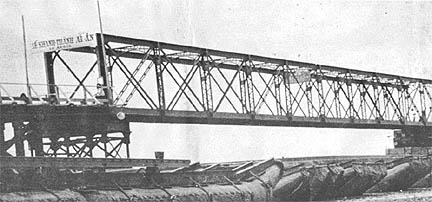 |
| CONSTRUCTION COMPLETED - The newly completed Trang Bang bridge spans the Trang Bang River in Tay Ninh Province. The bridge was reconstructed by the 65th Cbt Engrs, 25th Inf Div. The bridge was originally built by the Japanese during World War II and was later destroyed by the Viet Minh forces. Before the bridge was rebuilt the people had trouble getting their goods to market. The only means they had of transporting their goods to the other side was by ferry. Sampans were used as ferries, but this created a middleman and cost the people time and money. The bridge will also provide 25th Inf Div convoys with an easier access to northbound routes. MG F. K. Mearns, commanding general of the 25th Inf Div, cut the ribbon, opening the bridge. Hundreds of people were on hand for the opening. After the bridge was open the happy people crowded across the bridge. (Photo by 1LT Al Karel) |
|
|
Page 4-5 TROPIC LIGHTNING NEWS September 18, 1967
Placid River Sleeping Giant Until Monsoon
Photos by Sp4 Robert Fungaroli
DAU TIENG - Born in the high ground near Cambodia, the Saigon River
ambles along at a snails pace as it winds through the dense jungle of War Zone
C, past Dau Tieng, and then on to Saigon and the sea. From it's
birthplace to Dau Tieng, this placid river is not more than 32 meters wide at
any point during most of the year, but when the monsoon rains dump tons of water
on the parched earth and jungle left by months of drought, the stream begins to
bulge and stretch, out across the countryside. It fills the arid rice
paddies, and nourishes the water-starved land for one more year.
Across this sleeping giant, the main supply route for the 3rd Bde,
25th Inf Div, leads from Dau Tieng, across the river and on through rubber
plantations, small villages, and rice paddies to Tay Ninh. Constant
dumping of laterite (a gravel clay) has built the road up above the ground but
the Saigon River, fed by heavy rains engulfed the road recently just outside Dau
Tieng. Two to five feet of water suddenly covered the supply route for
some 200 meters.
Realizing that the water was not going to subside quickly, the men
of Co D, 65th Eng Bn rapidly began construction of a timber trestle bridge to
span the flooded portion of the road.
Working in water up to their knees, the engineers first
built small sandbag dams to block the water and allow the supports to be
implaced. Timber and prefabricated steel bridging was then emplaced and
within two days the road was again passable although the center span had not
been completed. After passage of the needed convoy on the third day, the
engineers emplaced the final span.
The road now stands high and dry over the Saigon flooded area, as
the big cargo trucks rumble across the new bridge, bringing to Dau Tieng the
needed supplies for a fighting brigade.
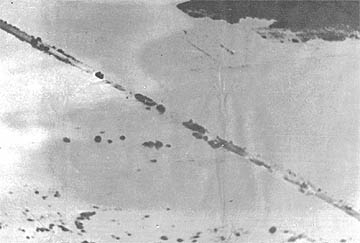 |
Split by waters of the Saigon River the road looks like a Morse code message with the dots and dashes. |
| With water all around, men fill sandbags for the dams needed to divert the water from the trestle points. | 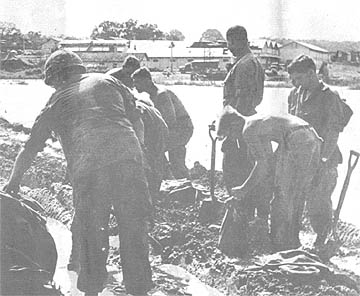 |
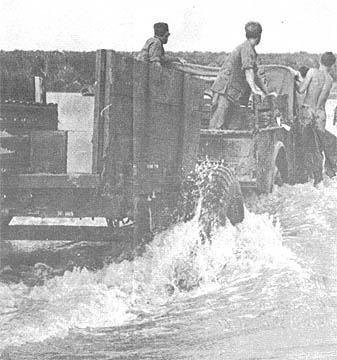 |
A trailer load of timber beams splashes across the river to the far bridge site. |
| The completed span stands high and dry over rice paddies flooded by the Saigon River. | 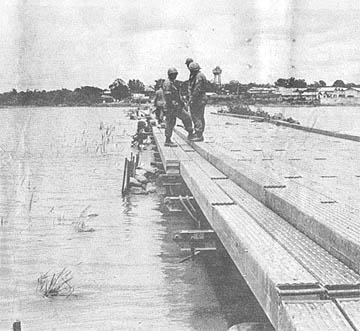 |
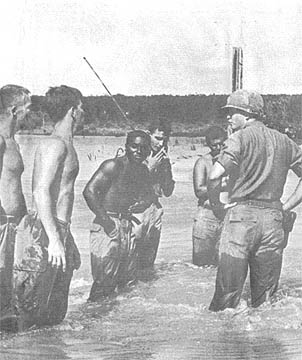 |
A group of Engineers from the 65th Engr Bn discuss the construction of the bridge. |
Page 6 TROPIC LIGHTNING NEWS September 18, 1967
Man, Dog Reunite
"When I saw that big head come poking around the corner near my
bed, I couldn't believe it . . . I thought he'd had it."
That "big head" belonged to a 75-pound German Shepherd scout
dog called "Duke." He and his handler, PFC David M. Monger of Fountain
City, Ind., were reunited in Ward One of the 25th Med Bn.
The two had last seen each other at the Medevac pad Sunday after
both had been brought in by a dustoff chopper - wounded when Bravo Co of the 2d
Bn, 14th Inf, was ambushed in the Iron Triangle.
"It was noon and we had just been taken off the point," the
19-year-old soldier recalled. "The jungle was just too thick. A
point man needed a machete and you can't chop and handle the dog at the same
time."
The platoon was moving in two files. Monger and Duke moved
back until they were third in line in the right file. In this formation,
they moved up on a hooch in an area where the jungle thinned out a bit.
Here, Charlie was waiting in his L-shaped ambush.
"Duke didn't give an alert," Monger explained, "because he
relaxes unless he's out on point. That's the way they're trained."
"The first round, from an M-79, killed the man in front of me,"
Monger said. "Then they detonated a claymore between the two files,
killing the point man and hitting me in the left arm and right thigh."
Man and dog dove into a trench off to the left and were pinned down
for twenty minutes.
"It was a three-ring circus in there for a while," the handler
said. "I was trying to stop the bleeding in my arm, keep the dog from
getting his head blown off when he tried to get up and see what was happening,
and at the same time keep up a good rate of fire."
Finally a squad leader made it to the trench and the three crawled
back to a rear platoon and then to a clearing for the dustoff.
"I didn't know Duke had been hit until we were sitting in a
crater waiting for the copter," Monger said. "I could see some
swelling in his side, but very little blood, so I figured he had a couple of
broken ribs. They told me at the hospital that he'd been hit near the
lung and they couldn't operate without puncturing it.
"He already has a piece of shrapnel in him and I was sort of
hoping they'd say he wasn't fit for duty so I could take him home. But
they tell me he'll be going back out into the field again in about two
months."
| TAKE IT IN THE CHIN - Duke is apparently glad to see his handler, PFC David Manger. The two were united in a 25th Med. Bn. ward. (Photo by SP5 Bryan) | 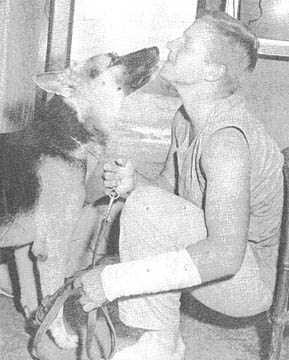 |
7 day Refresher Crs. For Old and New Alike
In seven days, combat troops who recently arrived in country to the
2d Bn, 14th Inf, will be participating directly in 25th Div combat operations.
Although initially well trained, they will be refreshed on new Vietnam
developments with particular emphasis on local conditions and operations.
MAJ Charles Fulkerson of Reno, Nev., who is directing the
operational phases of the training said, "The refresher training allows us to
pass out many of the recent lessons learned in Vietnam to the men in the
battalion. This makes it more of a challenge to the instructors as they
must make their pitch to both the old and new personnel."
Combat experienced officers and NCOs are conducting these classes.
PSG Lawrence Lackey of Columbia, Ga., an instructor in mines and booby traps
mentioned, "My experience as a recon platoon sergeant has given me an
opportunity to observe VC methods of laying mines and booby traps. These
are methods which can be learned and identified."
The men will be refreshed on such vital subjects as M-16
maintenance, VC tactics, civic action, air and artillery support, mines and
booby traps and helicopter operations. In addition to classroom training
the men will be given practical training in the field to include such subjects
as patrolling and reaction firing.
"The emphasis will be on recent developments and lessons learned
in Vietnam as applied to local areas of operation. This means that the
training is directly valuable and applicable to both the old and new
personnel," Fulkerson concluded.
| The lightning two-five radio program which is normally broadcast at 11:45 a.m. will now be aired at 1:05 p.m. on Saturdays. For fine entertainment and interesting interviews be sure to tune in to AFVN. |
Gift Stops Fragment
"I shall never die a sudden death," were the words written on a
prayer paper that stopped fragments from a bullet.
"We were caught in a cross-fire," relates PFC Robert Conte of
Revere, Mass., "and bullets were coming in from all directions. All of a
sudden, I felt a sharp rap on the back of my head."
On examining his steel helmet and helmet liner, Conte found that a
bullet had penetrated his helmet and the fragments had torn through his liner to
be stopped by the rolled up prayer paper.
The 25th Inf soldier said he was given the prayer paper by another
man who had fought with the 2d Bn, 14th Inf, for a year without injury.
1200 Happy Faces
Multiply one happy face by 632 and you have the amount of happiness
medics of the 25th Inf Div's, 2d Bde brought in one day to the villagers of
Hiep Hoa.
Just the day before, many of the same doctors treated another 600,
bringing medical relief to more than 1200 Vietnamese in two days.
The cry "Bac Si" raced through Hiep Hoa soon after the
villagers finished breakfast. The word, Vietnamese for doctor, signaled
the entrance of doctors from five American units and nurses from Province Health
Service.
While medics set up examining lines, old people hobbled out of
their homes, sick young people came, and mothers brought their children.
The medics, from a local Special Forces camp, 2d Bde Hqs, the 1st
and 2d Bns, 27th Inf, and the 1st Bn, 8th Arty, were joined by a 25th Div
dentist.
Many villagers told about earlier doctors when they thanked the
American soldiers, but they all said they had never before seen a dentist.
Together, the medical team treated everything from tooth ache to
severe leprosy. Arrangements were made for evacuation of several
Vietnamese to military hospitals for further treatment.
By the end of the day, the medics left exhausted. As one
doctor said, "There was so much we couldn't do, but at least Hiep Hoa went
to sleep tonight a little happier than it woke up."
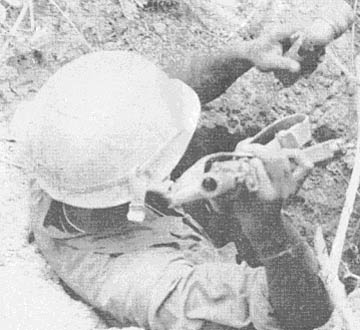 |
GOING DOWN - With a rifle and a flashlight ready a 1st Bn (Mech), 5th Inf, tunnel rat prepares to enter a Viet Cong Tunnel. (Photo by 1LT Al Karel) |
Page 7 TROPIC LIGHTNING NEWS September 18, 1967
Bad Spot For Good Camouflage
DAU TIENG - Two Viet Cong who went to great pains to make
themselves and their bicycles look like one big bush made one costly mistake
near here recently. They planted the bush in the middle of a road.
"I was flying back from a mission," related 1LT Wentlell M.
Wilson of Greenville, S.C., a forward air controller for the 19th Tactical Air
Support Sqdn stationed at Dau Tieng, "When I saw a big bush in the middle of
the road leading northward out of the plantation."
"The camouflage was beautiful and if they had been off to the
side I would have never spotted them," he continued. "I had to look
twice as it was."
As Wilson flew overhead, the two VC stayed on the road for several
minutes and then decided to move to the side.
"It was really funny watching this bush skitter off to the side.
I could see the man in the back because his covering only went down to his knees
and I could see his legs moving under the bush."
An airstrike was called by Wilson and within minutes F-100 fighters
were over the target strafing the area.
"When they were through, the area around the road looked like it
had the measles," concluded Wilson.
Result of the action: one moving bush neutralized.
Four-sided Steel Dozer Foxholes
DAU TIENG - The engineers of Co B. 588th Cbt
Engrs, have come up
with a new way to beat digging foxholes at night. They drive their
bulldozers together using the blades as four-sided steel walls.
The engineers are operating with the 2d Bn (Mech), 22d Inf, of the
25th Div's 3d Bde, clearing the road north of Nui Ba Den mountain.
"We usually just dig a small hole at night with one of the
blades," said PFC Michael Sonny of Masury, Ohio, "but at the beginning of
the rainy season we scooped out a hole one night, it rained, and flooded us
out."
For the rest of the rainy season the engineers decided to circle
the dozers.
25th GI Meets CoC President
A letter of introduction from the Mayor of Denver to the President
of the Takayama, Japan, Chamber of Commerce, led to an exciting and interesting
two days for a 25th Inf Div soldier.
Denver and Takayama became sister cities during the term of the
late President Kennedy.
SP4 Malcom D. Kaiser, assigned to the 125th Sig Bn, wrote his
parents in Denver that he was taking his R&R in Japan.
Denver's mayor heard about Kaiser's intended visit, and decided
to send Kaiser a letter introducing him to the President of the Takayama Chamber
of Commerce.
The letter was sent to Mrs. Kaiser, who forwarded it to her son.
When Kaiser received it, he wrote to the Chamber of Commerce president and
relayed his intentions to visit the city.
Kaiser flew to Tokyo, then took a train to Takayama where he was
greeted by the President of the Chamber of Commerce, a local doctor, and an
interpreter.
The group spent the remainder of the day getting acquainted, then
had supper at the Kanko Hotel.
Lightning Raids New Tactic
Lightning swift single platoon raids are a brand new tactic being
used with great success by 25th Inf Div "Wolfhounds."
In a recent assault, men of Co A, 1st Bn, 27th Inf, teamed up with
gunships of the 116th Aslt Hel Co to kill 18 Viet Cong and detain 27 suspects.
There were no friendly casualties.
"Big battles are spectacular," says Battalion Commander LTC
David Hughes of Colorado Springs, Colo., "but it's the smaller day to day
successes like this that really add up.
"This particular raid that we called the 'little hootch raid'
was a prime example," he said. "On a series of five strikes we made
that day, we hit action on the third."
Working on intelligence information the platoon, scrambling off
assault helicopters, caught an estimated 30-man Viet Cong force apparently
holding a meeting in a small house.
The enemy soldiers fled, many of them into nearby open fields.
As the platoon pursued, helicopter gunships orbiting overhead
struck with rockets and machine gun fire. Together, the ground and aerial
forces accounted for the 18.
Detainees were taken as the platoon swept after the enemy soldiers.
They were removed for questioning by Vietnamese authorities.
"When the Wolfhounds first came to Hau Nghia Province it was
controlled by the Viet Cong," says Hughes, "and tactics like these platoon
raids have now made it highly unpopular with them."
Engrs In RD
A Revolutionary Development project has begun in the village of An
Duch, northwest of Saigon.
The project, which involves Co C, 554th Engr Bn, and elements of
the 3d Sqdn, 4th Cav, consists of aiding the villagers in upgrading and draining
the area in the vicinity of the village slaughter house.
Health Problem
In the past there has been a serious health problem, due to the
disposal of wastes and. improper drainage. The problem is being solved by
the dumping of laterite and by showing the villagers how to properly drain the
area.
Self Improvement
In addition there is an effort underway to repair the school
playground by preparing the ground for equipment to be delivered at a later
date.
The engineers hope to spark a program for the Vietnamese to improve
their own village.
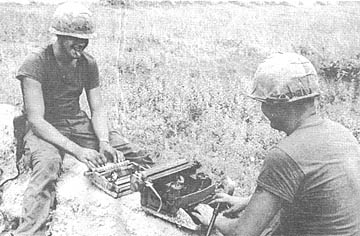 |
TAKE A LETTER - SGT Paul Hilbrect (left) of Clarence Center, N.Y., and SP4 Joseph Hendrick of Bowling Green, Ky., loosen up their fingers on two typewriters found in an underground Viet Cong tunnel. The 1st Bn (Mech) 5th Inf, has uncovered a quantity of such tunnels along the Oriental River, 40 kms northwest o f Saigon, while participating in the 25th Div's Operation "Kolekole." (Photo by 1LT Al Karel) |
Interpreter Trap
A softspoken Vietnamese interpreter who laid a verbal trap for a
Viet Cong, also talked the man into rallying to the side of the government.
The rallier then led the 1st Bn (Mech), 5th Inf, to a series of
storage bunkers.
SSG Nguyen Thang Long, attached to the 25th Inf Div unit's Co B,
was brought in to interrogate a group of detainees after a heliborne combat
sweep.
"As soon as I began talking to him I realized that he was a Viet
Cong," Long said. "I laid a trap and he fell right into it.
After he realized just what he had said, he admitted being a VC.
"I explained to him that the Americans were his real friends and
that they were here to fight for the people's freedom," he said.
Soon after the gentle talk, the new rallier led the battalion to
five reinforced concrete bunkers and three spider holes.
Pot Saves Another GI
Imagine getting hit on top of the head by a baseball bat. SSG
William Roach of Marion, Ind., experienced such a feeling while on a river
assault with an element of the 25th Div's 2d Bn, 14th Inf.
Roach had gotten off a River Assault Group (RAG) boat and was
making his way through some heavy brush along the shore of the Saigon River,
when he heard the snap of a sniper's bullet.
Seconds after he dropped to the ground a bullet hit his steel
helmet.
Page 8 TROPIC LIGHTNING NEWS September 18, 1967
Refugees Resettle From Dau Tieng
DAU TIENG - From tents on a barren hillock to permanent brick homes
with a small garden plot in the backyard - this is the change which 180 refugees
from Dau Tieng made recently when they moved with all their household goods to
the permanent resettlement area of Lai Thieu.
The move was coordinated by the Tri Tam district officials, who
worked with the transportation officer of the 25th Inf Div in providing the
three CH-47 "Chinook" helicopters which were used for the move.
The day prior to the exodus, Vietnamese officials went to the
refugee camp and announced that the next day the people would be moving to the
Lai Thieu resettlement area. They would take all their household goods
including their livestock.
The following day, the big Chinooks began to load the people and
fly them to Lai Thieu. The manifest was run by the district officials and
the entire lift went smoothly with only one minor problem.
"The only problem we had during the move was that the downdraft
of the helicopters blew the lid off one of the chicken boxes and we had to chase
down the escaped birds," related CPT Vinton D. Loucks, civil affairs officer
for the 3d Bde, 25th Div.
Throughout the short flight to Lai Thieu, the refugees were
concerned about what it was going to be like when they arrived. Their
apprehensions were quickly dispelled when they were greeted by the smiling faces
of other refugees who met them as the choppers landed beside the new tin-roofed
brick buildings that would be their new homes.
Displaced during Operation "Manhattan" in May, the refugees
have been living in a small camp in Dau Tieng. Clothing, food, and other
essentials were provided to them as payment for the work they did in the
village's public works program.
| The 25th Infantry Division Information Office is presently compiling material and photographs of all division activities from 1 October 1966-1 October 1967. Anyone having good color, black and white, or color slide photographs of combat, civic action, or any other division activities, please bring them to the PIO and give them to LT Rottmann or PFC Hairston. If you desire, the photos will be returned, unharmed, after they are copied. Also any interesting sketches in pencil, ink, or water color can be used. |
Trouble Doubles
A dark jungle trail and a loose bootlace can cause a man to stumble
into all sorts of trouble.
PFC Oscar Taylor of Medina, N.Y., was on patrol with an element of
the 4th Bn, 9th Inf, in the southern tip of the Iron Triangle 57 kms north of
Saigon, when it happened - he tripped over a loose bootlace and pitched forward.
As he fell a Viet Cong popped up from the heavy brush, aimed his
automatic rifle at Taylor and pulled the trigger. The weapon jammed and before
the VC could clear it, PFC James McDonald of Mahopac, N.Y., killed him with his
machinegun.
Thurman Takes Command Of 25th Division Artillery
LTC T. C. Thurman this month assumed command of the 25th Inf Div
Arty, succeeding COL David E. Ott who moved to the Pentagon as chief, Officer
Personnel Operations, Artillery.
During the change of command ceremony at Div Arty headquarters, Ott
was presented the Distinguished Flying Cross, the Legion of Merit (1st oak leaf
cluster) and the Vietnamese Cross for Gallantry with gold star.
The presentations were made by MG F. K. Mearns, 25th Div commanding
general, and BG Chinh, artillery officer, III Corps, Army of Vietnam.
Thurman came to Vietnam in 1965 following graduation from the Naval
War College, Newport, R.I. His first in-country assignment was chief of
schools division, Military Assistance Command, Vietnam (MACV). In March
1966 he became the senior advisor, Phouc Tuy Province, and in July of last year
moved to the American Embassy in Saigon as assistant mission coordinator in the
office of Ambassador Lodge.
Thurman's next assignment was commanding officer of the 1st Bn,
8th Arty, 25th Div. He served there since last January.
A native of High Point, N.C., Thurman attended North Carolina State
College in Raleigh, N.C., and graduated from the U.S. Military Academy in 1946.
He has attended artillery career courses at Ft. Sill, Okla., and
Command and General Staff courses at Ft. Leavenworth, Kan.; the Armed Forces
Staff College, Norfolk, Va.: and the Naval War College.
He holds a master of science degree in International Affairs from
George Washington University, Washington, D.C.
| TAKES OVER - LTC T. C. Thurman, new commander of the 25th Inf Div Arty, is handed the Div Arty colors in a change of command ceremony. Left to right: BG Chinh, artillery officer, III Corps, AVN; COL David E. Ott, former commander of Div Arty who is rotating; MG F.K. Mearns, 25th Div CG; SGM Carl D. Craner, Div Arty sergeant major; and Thurman. (Photo by SSG Swift) | 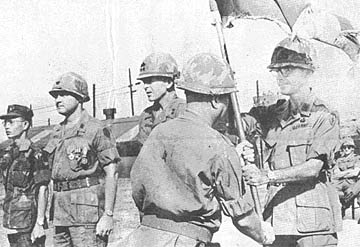 |
Whiskey Papa Navigation Aid
In the dense jungles of Vietnam artillery plays the role of
navigator. When the map and compass method of navigation cannot be used
because of jungle growth or darkness, the burden of navigation falls upon an
artillery forward observer (FO).
Traveling with Co C, 1st Bn, 27th Inf, is 1LT Roger L. Hipwell of
Minneapolis, Minn. Although attached to the infantry, Hipwell is assigned
to Btry A, 1st Bn, 8th Arty, as one of nine FOs who support the 25th Div's 2d
Bde.
The problem of navigation is solved by radio transmission to the
fire direction center located at the battery's firing position.
The call sounds like this: "Ancient Valley 9, this is Ancient
Valley 41, fire mission, over . . . . grid 613461, direction 3210, request one
round Whiskey Papa, 200 meter height of burst, over. . . .
Within minutes a round is fired. The FO has requested a white
phosphorus smoke round with a time fuse set to explode in the air on azimuth
3210.
After the battery's center howitzer or "base piece" receives
the firing data from the fire direction center a round will be fired on the
required azimuth. The explosion will occur near the unit if the estimate
of their position is correct. The burst creates a brilliant cloud of white
smoke, placing a marker in the sky.
Observing the burst can verify the unit's position. If the
burst is not observed another round is requested to the left or right of the
original burst. When the FO observes the explosion, he plots his location.
With land navigation still a necessity in Vietnam, artillery's
role as a navigational aid continues. The guiding light of a navigational
round is just one phase of artillery's role. A role that will omit the
word "lost" from field manuals!
Gen Westmoreland May Award Medals
WASHINGTON - The Department of the Army has delegated authority to
General William C. Westmoreland, commander of the Allied Forces in Vietnam, to
approve the award of the Valorous Unit Award and Meritorious Unit Commendation
to U.S. and Free World units serving in Vietnam.
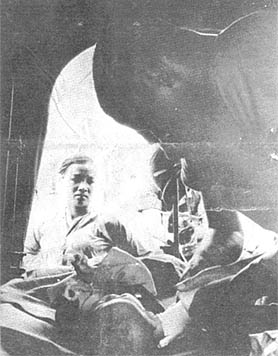 |
MOTHER'S CONCERN - A concerned mother looks on as her baby's broken arm is looked after by a medic on a 1st Bn (Mech), 5th Inf, MEDCAP. (Photo by 1LT A.R. Karel) |
Thanks to
First Sergeant O.N. Davisson, 25th Aviation Bn. for sharing this issue,
Ron Leonard, 25th Aviation Bn. for locating and mailing the issue,
Kirk Ramsey, 2nd Bn., 14th Inf. for creating this page.
This page last modified 8-12-2004
©2004 25th Infantry Division Association. All rights reserved.